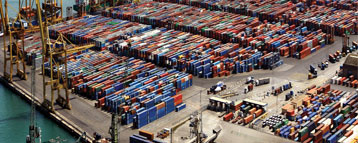
Riding the green wave
Becoming a green port involves varied factors: the disposal of shipboard waste, ecological compensation, treatment of dredged material and alternative energy concepts for its own business premises are just some of the many ‘green logistics’ activities carried out by ports, with the aim of reducing ecological impact to a minimum. In a recent move, the […]

Becoming a green port involves varied factors: the disposal of shipboard waste, ecological compensation, treatment of dredged material and alternative energy concepts for its own business premises are just some of the many ‘green logistics’ activities carried out by ports, with the aim of reducing ecological impact to a minimum.
In a recent move, the US Environmental Protection Agency (EPA) has launched an initiative to recognise ports that take action to improve environmental performance. The new initiative is expected to provide additional incentives to improve a variety of environmental issues, including improving local air quality, reducing carbon emissions, and addressing environmental justice issues, EPA said in a statement.
The agency said it will also work with port authorities to develop emission measurement tools, which will help ports better understand their energy use and environmental impact.
“Ports are the main gateway for US trade and are critical to our country’s economic growth, yet the communities surrounding ports face serious environmental challenges,” said EPA Administrator Gina McCarthy at the launch of the initiative on April 8. “Today we demonstrate that through collaboration and innovation we can achieve the goals of economic growth and environmental stewardship.”
Separately, EPA has awarded $4.2 million in grant funding for clean diesel projects at six US ports – Port of Seattle, the Port of Hueneme, the Port of Tacoma, the Maryland Port Administration, the Virginia Port Authority, and the Port of Los Angeles.
The $4.2 million in Diesel Emissions Reduction Act (DERA) grants will be used by the six ports “to retrofit, replace, or repower diesel engines resulting in immediate emissions reductions in harmful pollution,” said the agency.
Ports are also doing their bit to ride on the green wave. In a recent development, two west coast Canadian ports have started offering financial incentives to vessels complying with a green shipping standard, in a move that campaigners hope will soon be replicated around the world.
Port Metro Vancouver and the Prince Rupert Port Authority have decided to offer discounts to ships docking in their ports that meet a minimum level of environmental performance. To be eligible, ships must comply with the ‘A to G’ standard for carbon emissions in international shipping. Under the scale, developed by non-profit organisation Carbon War Room and maritime risk management software firm RightShip, ships are rated for their greenhouse gas emissions on a scale from A to G, based on the emissions of other vessels with a similar size and shape.
The new incentive builds on a record of environmental improvement at the two ports. Port Metro Vancouver (PMV) is Canada’s largest port, and a major shipping terminal between Canada and the Pacific Rim. It runs an ‘EcoAction’ initiative, which it said offered $1.1m in discounts last year to ships that embraced cleaner fuels and improved engine technology. The incentive represents 10 per cent of its revenue from deep sea harbour vessels, offering shipping operators significant savings if they meet the standards.
Similarly, Prince Rupert runs an Environmental Incentive Program for Vessels known as EIPV or ‘Green Wave’. It expanded the scheme to include the A-G ratings and plans to give away $100,000 in discounts this year.
The port will award discounts based on ship’s performance in these rankings, as well as their position in the Energy Efficiency Design Index, which has been developed by the International Maritime Organisation, and the Clean Shipping Index. It also takes waste control and chemical usage into account, awarding ships a score based on a points and colour system.
With the industry under growing pressure to adopt an international carbon pricing mechanism to help drive investment in cleaner technologies - pressure that some shipping operators are keen to resist by adopting more voluntary measures to curb emissions.
The Port of Montreal has also been taking measures to reduce its environmental footprint out in the field. In March 2011, the port implemented a new truck entry portal that has reduced transaction times by 80 percent and waiting times by 50 percent. In 2011, the project earned an Award of Excellence in the Transportation and Merchandise category from l’Association québécoise du transport et des routes (AQTR). The port’s fleet of service and maintenance vehicles is gradually being phased out and replaced with hybrid vehicles that reduce greenhouse gas emissions (GHGs) by 39 percent. The port’s locomotives have been replaced with multiple-generator locomotives that reduce greenhouse gas emissions (GHSs) by 90 percent and fuel consumption by 54 percent.
The Port of New York and New Jersey has extensive environmental programs, ranging from proposed strategies to reduce air emissions from shipping to an Environmental Management System (EMS) to reduce impact from facilities’ operations.

